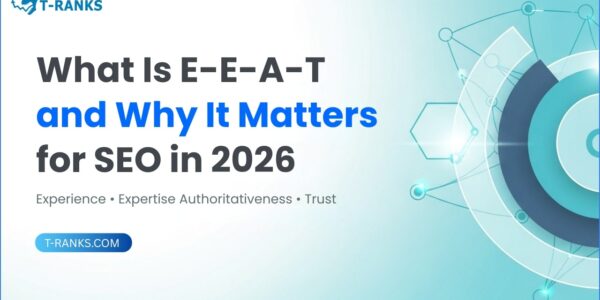EEAT stands for Experience, Expertise, Authoritativeness, and Trust.
It’s Google’s way of measuring whether your content is reliable, helpful, and created by real people who know what they’re talking about.
In 2026, E-E-A-T has become one of the most important parts of SEO. It affects how your pages rank on Google and how often they’re cited in AI tools like Gemini, ChatGPT, and Perplexity.
Think of it as Google’s “trust score.” The more proof you provide real experience, expert input, credible sources, and transparent updates the more visible your brand becomes across search and AI results.
In this guide, you’ll learn how E-E-A-T works today, why it drives visibility in the AI era, and the exact steps to make your content more trusted, more discoverable, and more future-proof.
What E-E-A-T Means (Experience, Expertise, Authoritativeness, and Trust)

E-E-A-T stands for Experience, Expertise, Authoritativeness, and Trust.
It’s Google’s framework for evaluating whether your content is reliable, accurate, and created by real people who know their subject.
Google introduced E-A-T in 2014 through its Search Quality Rater Guidelines. In 2022, it added another E for Experience, showing how valuable firsthand knowledge has become. By 2026, E-E-A-T evolved into a key part of Google’s ranking system, especially for AI Overviews and content verification.
E-E-A-T isn’t one single ranking factor. It’s a group of signals that help Google answer questions like:
- Who created this content?
- Can they be trusted?
- Do they have real experience with this topic?
Let’s look at each part in simple terms.
Experience – Show Real, Firsthand Knowledge
Experience means proving that your content comes from personal use, testing, or observation. Google values pages written by people who have actually done what they’re talking about.
How to show experience:
- Add photos, screenshots, or short clips showing your own work or testing.
- Include notes, results, or timelines from real projects.
- Mention tools, products, or data you personally used.
- Add small context cues like “Tested in September 2025” or “Used for 30 days.”
These details tell Google (and readers) that your content is genuine and not just AI-generated or copied research.
Expertise – Prove You Know the Topic
Expertise focuses on your qualifications and accuracy. Google wants proof that your content comes from someone who understands the subject deeply.
How to show expertise:
- Add a short author bio with experience or credentials.
- Include a “Reviewed by” section for expert verification.
- Cite reliable sources like government sites, studies, or journals.
- Explain how your data or examples were collected.
- Keep an editorial or update policy visible to show accountability.
Strong expertise helps your pages rank higher, especially for sensitive or “Your Money or Your Life” (YMYL) topics such as health or finance.
Authoritativeness – Earn Recognition from Others
Authoritativeness is about how others view you or your brand online. When credible sites mention, link to, or quote your content, it signals authority.
How to build authority:
- Earn backlinks from trusted websites in your niche.
- Publish original studies, data, or guides that others can reference.
- Join industry groups and display certifications or memberships.
- Appear in webinars, podcasts, or media interviews.
- Use schema markup (like sameAs) to connect your online profiles.
Google notices when others trust your insights — that’s what builds authoritativeness over time.
Trust – Build Safety and Transparency
Trust is the foundation of E-E-A-T. Even with great content, your site won’t rank well if users or Google don’t see it as safe and honest.
How to build trust:
- Use HTTPS and keep your site secure.
- Display ownership details, contact info, and disclosures.
- Add privacy, cookie, and AI-use policies.
- Keep your content accurate and updated.
- Ensure your website loads fast and is accessible for all users.
When visitors feel safe and informed, they stay longer — and Google rewards that behavior with higher visibility.
In Summary:
E-E-A-T is Google’s way of deciding who to trust online. It rewards creators who share genuine experience, show real expertise, earn recognition from others, and maintain transparency. When you build content around all four pillars, you strengthen your brand’s credibility and improve your chances of ranking higher in both Search and AI-driven results.
E-E-A-T and AEO: Building Trust for AI Search and Overviews

In 2026, E-E-A-T and AEO (Answer Engine Optimization) work together to define how your content appears in AI-powered results.
E-E-A-T builds trust and credibility. AEO makes sure your content is structured and clear enough for AI systems to understand, extract, and cite.
As Google, Chatgpt , and Perplexity move from showing blue links to generating direct answers, this partnership between trust and structure has become the core of modern SEO.
If your content shows real experience, verified expertise, and transparent authorship, it has a much higher chance of being featured or cited in AI Overviews and large language models.
In simple terms, E-E-A-T tells AI that you are trustworthy, while AEO makes your information easy to read, quote, and display.
How E-E-A-T and AEO Work Together

E-E-A-T powers SEO by giving AI engines the confidence to use your content.
Google’s ranking systems and AI models use E-E-A-T signals to decide which pages deserve to appear as sources.
Here’s how each part contributes to AI visibility:
- Experience shows real use or testing through images, data, and examples.
- Expertise confirms professional skill with author bios and expert reviews.
- Authoritativeness comes from citations, mentions, and consistent entity data.
- Trust depends on honesty, site safety, and verified facts.
When these four elements are visible, AI engines can easily extract information, cite your site, and display your brand as a reliable source.
Optimizing Content for AI Overviews
AI prefers content that is simple, clear, and well-organized.
To make your pages easy to understand and cite:
- Begin each topic with a short, direct answer (around 50–80 words).
- Use lists or tables to show key information clearly.
- Keep URLs consistent to maintain stable citations.
- Add schema such as FAQPage, Speakable, or Article with citation properties.
These steps make your pages easier for AI systems to read, summarize, and attribute correctly.
Strengthening Your E-E-A-T Signals
AI engines verify trust, not claims. Strengthen your proof with visible evidence:
- Use original photos or videos that include verifiable metadata.
- Write author bios with real qualifications and add expert reviewers for sensitive topics.
- Connect your brand and team profiles using sameAs schema for consistent entity identity.
- Keep your site secure and transparent with clear policies and contact details.
When your content is verifiable, AI systems see it as credible, and readers see it as honest.
Use the Answer-First Writing Method
AI systems favor content that gives clear answers before explanations.
Start each section with a short summary sentence that answers the question, then add context, proof, and detail.
This mirrors how AI Overviews extract content and how readers process information.
It keeps your writing focused, easy to follow, and ready for both human and machine interpretation.
Measure and Improve Continuously
Optimizing for E-E-A-T and AEO does not end after publishing.
Track your results and refine based on what you find:
- Check Google Search Console for impressions and clicks from AI Overviews.
- Search for your brand or site in Gemini, ChatGPT, or Perplexity to see if you are cited.
- If you appear in AI results without attribution, review your schema and author data.
Visibility without credit has little value, so make sure your brand earns recognition whenever it is mentioned.
Koray Framework and PPR: How to Prioritize E-E-A-T Optimization
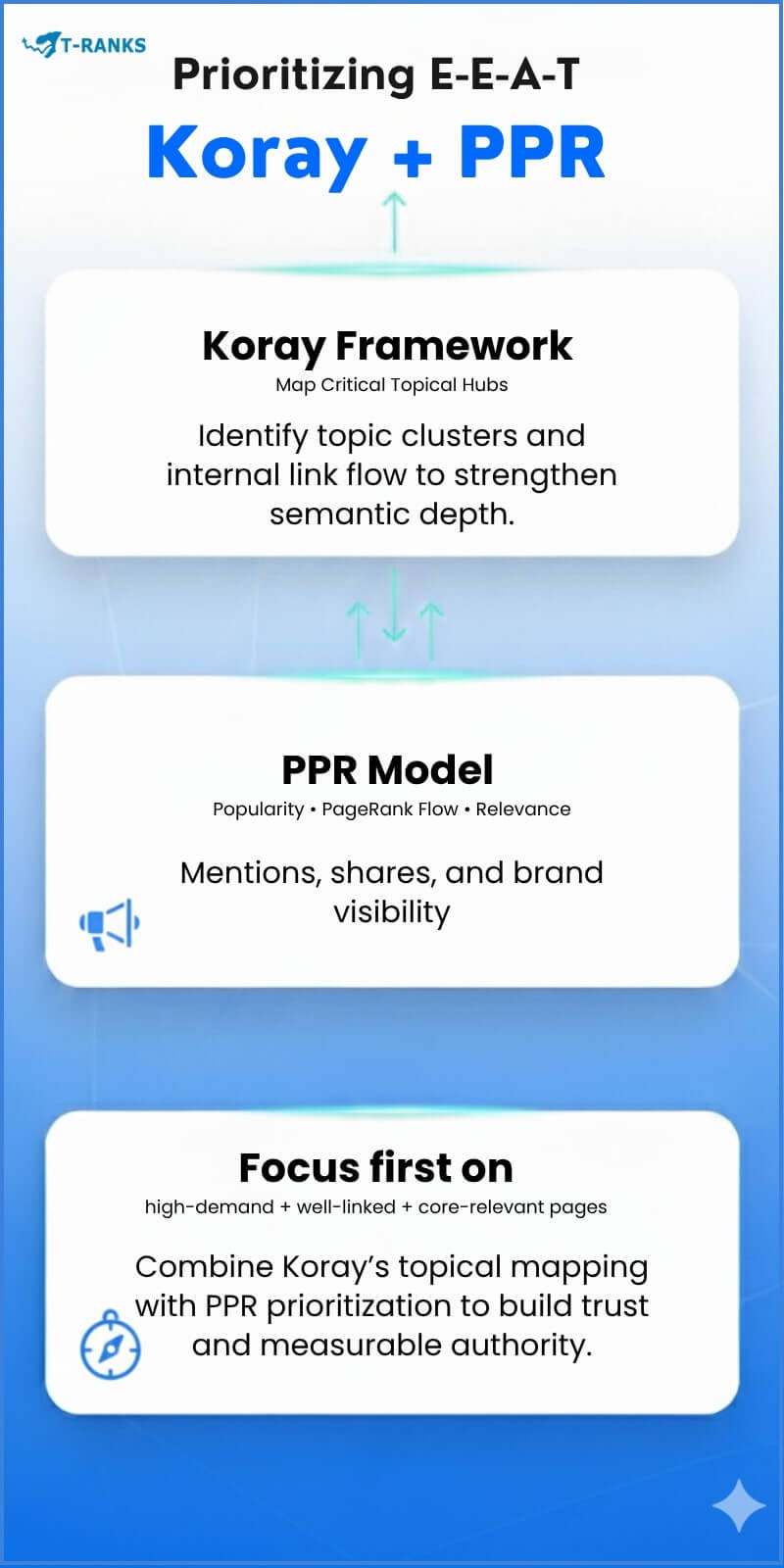
Building E-E-A-T across your entire website can feel overwhelming.
That’s where the Koray Framework and PPR Model come in.
Together, they help you decide which pages deserve your E-E-A-T focus first ,so you can spend time and effort where it matters most.
The Koray Framework, developed by SEO expert Koray Tuğberk Gübür, views your website as a connected system rather than a group of separate pages.
It helps you identify which topics or pages are central to your brand’s expertise and where Google expects to see the strongest trust signals.
This makes it easier to strengthen your authority within the topics that define your brand identity.
The PPR Model, which stands for Popularity, PageRank Flow, and Relevance, adds a scoring layer to this process.
It tells you where E-E-A-T updates will make the biggest difference.
Instead of guessing, you use data to decide which pages need expert reviews, citations, or structured data.
Here’s what each factor means:
- Popularity shows how much interest or search demand a topic has.
- PageRank Flow tracks how internal links pass authority across your site.
- Relevance measures how closely a topic matches your brand’s expertise or entity identity.
When you combine the Koray Framework and the PPR Model, you get a clear roadmap:
Start with pages that are popular, well-linked, and highly relevant to your core expertise.
These are the pages that deserve full E-E-A-T treatment, detailed author bios, expert reviews, citations, and structured data.
This method prevents you from spreading your resources too thin.
It ensures your most important pages get verified trust signals first, which helps your site earn visibility in both Google’s AI Overviews and LLMs like Chatgpt or Perplexity.
Over time, this focused approach builds stronger authority, better rankings, and a more credible presence across your entire topical ecosystem.
Building E-E-A-T with a Topical Authority Map and Trust Layers
A Topical Authority Map is more than a content plan it’s a blueprint for how your expertise is built and proven online.
It helps Google and AI systems see the full picture of your knowledge: how your topics connect, how trust flows between them, and how each piece reinforces your authority.
In simple terms, a topical map turns scattered articles into an organized knowledge ecosystem.
When every page connects around one central theme and carries clear trust signals, your site stops looking like a collection of posts and starts acting like a verified source.
How a Topical Map Builds E-E-A-T
E-E-A-T and topical mapping work together.
The topical map gives your content structure; E-E-A-T gives it credibility.
Here’s how that connection works:
- Experience appears when your supporting pages include real tests, data, or first-hand examples.
- Expertise grows as your authors and reviewers are consistently linked to related clusters.
- Authoritativeness strengthens when pillar and cluster pages reference each other and earn citations from trusted domains.
- Trust builds naturally as every layer of content includes transparent sources, reviewer notes, and structured data.
When search engines see this kind of consistency across an entire topic, they understand that your site doesn’t just discuss the subject it owns it.
The Five Trust Layers Inside a Topical Map
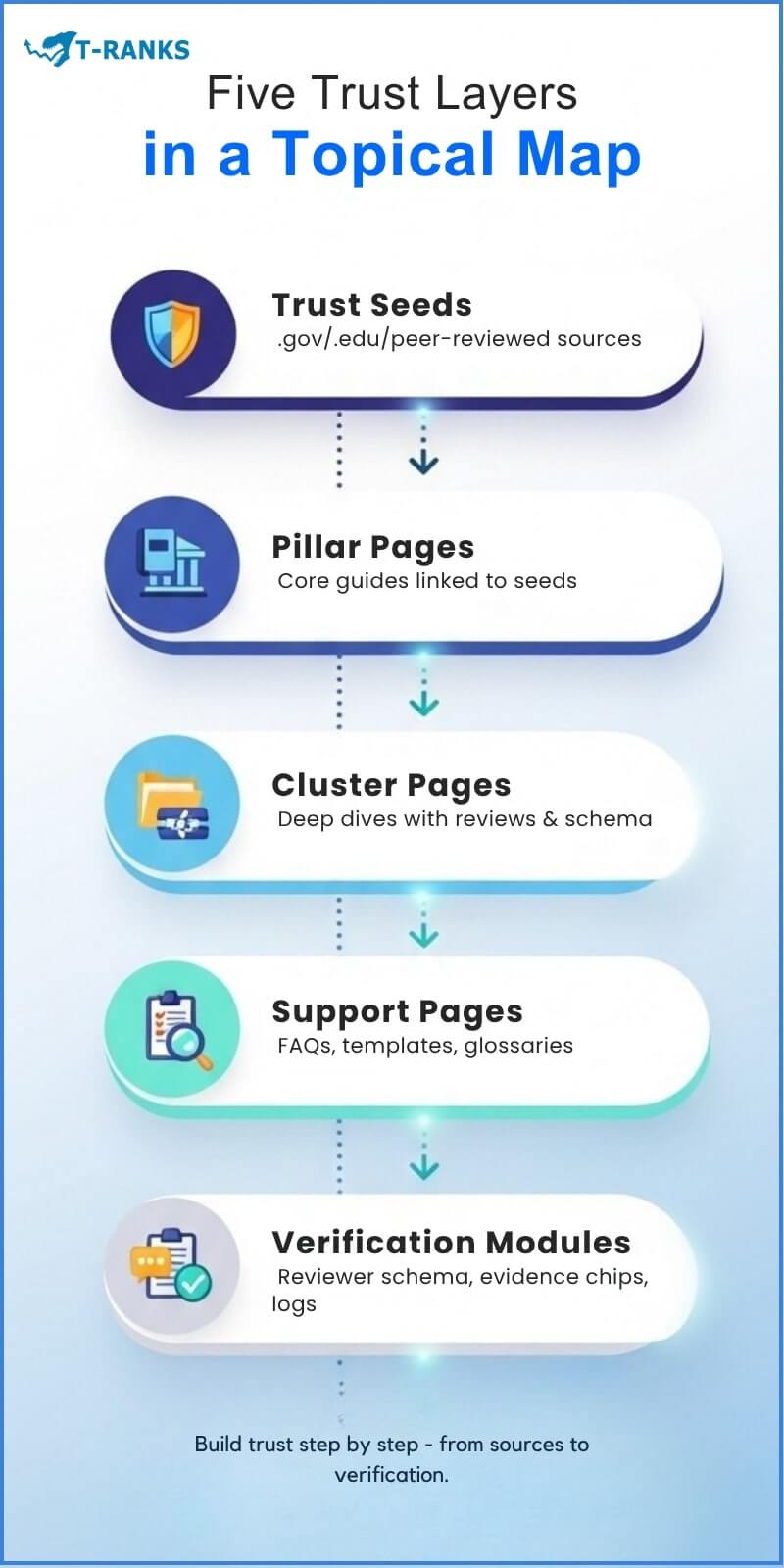
A strong topical authority map works through connected layers.
Each layer adds structure, depth, and verifiable trust.
- Trust Seeds – External authority sources such as .gov, .edu, or peer-reviewed publications that you cite or earn backlinks from.
- Pillar Pages – Core guides that define your main topic and link directly to trust seeds or primary data.
- Cluster Pages – Focused subtopics that dive deeper into each area and include expert reviews, citations, and schema.
- Support Pages – Tactical or practical assets such as FAQs, templates, or glossaries that keep your clusters fresh and interlinked.
- Verification Modules – Proof elements like reviewer schema, evidence chips (“Tested | Data Verified”), and transparent editorial notes.
Together, these layers form a living trust network that shows Google exactly how expertise, credibility, and authenticity flow through your site.
Why a Trust-Layered Map Strengthens SEO
A trust-layered topical map helps your E-E-A-T and search performance in several ways:
- It shows complete topic coverage, proving you understand every part of your niche.
- It transfers authority efficiently, moving link equity and trust from top-level sources down through your internal network.
- It reinforces credibility, as every page includes visible, verifiable trust signals.
- It attracts natural backlinks, since external sites prefer to cite content that is clearly organized and validated.
Over time, this system builds a stable foundation of authority across Google Search, Gemini, and Perplexity.
Each new page you publish joins the same verified framework, increasing your brand’s reputation and visibility.
How On-Page Optimization Strengthens E-E-A-T
E-E-A-T isn’t proven by words alone — it’s shown through visible, verifiable elements on every page.
Your on-page design and structure should demonstrate credibility at a glance. When users and search engines can see how your information was created, reviewed, and maintained, your content earns measurable trust.
Strong on-page signals turn E-E-A-T from theory into proof.
By using repeatable content modules, you can apply the same trust standards across all pages — pillars, clusters, and product content — without rebuilding from scratch each time.
Below are six reusable trust modules you can add to your content templates to make E-E-A-T visible and consistent across your entire site.
1. Methodology Box – Show How You Reached Your Findings
Explain exactly how your data, testing, or analysis was done.
This builds transparency and allows readers (and Google) to verify your process.
Include when and how the information was gathered, who reviewed it, and when it was last checked for accuracy.
Use on: Research reports, product comparisons, or data-driven articles.
Tip: Always update the dateModified schema when you refresh data.
2. Why You Can Trust Us – Summarize Your Credibility
Give readers a quick reason to trust you.
Mention who wrote and reviewed the content, where your data came from, and how your editorial process ensures accuracy.
This module humanizes your expertise while confirming your quality standards.
Use on: Pillar pages, About sections, and any YMYL topic.
Tip: Add author photos, short bios, and reviewer schema for extra credibility.
3. Disclosure & Limitations – Be Open About Bias
Transparency removes doubt.
If your content includes affiliate links, sponsorships, or opinions, disclose them clearly.
Explain how you test or evaluate products independently and note any details that may change over time.
Use on: Affiliate, sponsored, or review-based pages.
Tip: Link to a full disclosure or ethics policy in your footer for consistency.
4. Reviewer Notes – Highlight Expert Validation
Show that a qualified expert has reviewed your content.
Include the reviewer’s name, credentials, and a short statement confirming accuracy.
This is especially important for YMYL pages in health, finance, or legal topics.
Use on: YMYL and high-authority guides.
Tip: Add a small badge near the byline such as “✓ Reviewed by Dr. Jane Smith, PhD.”
5. Revision Log – Prove Freshness and Accountability
A visible update history shows your content is maintained and trustworthy.
List what was updated, who reviewed it, and when changes were made.
It signals that your information stays current and responsibly managed.
Use on: Pillar or evergreen content.
Tip: Sync the log with dateModified schema for stronger freshness signals.
6. Citation Footer – Display Verifiable Sources
Citations turn claims into proof.
List all authoritative references, including links to studies, reports, and credible publications.
This not only boosts E-E-A-T but also helps AI systems understand where your facts come from.
Use on: All major guides and YMYL clusters.
Tip: Add the citation property within your Article schema to reinforce transparency.
How Structured Data Supports E-E-A-T
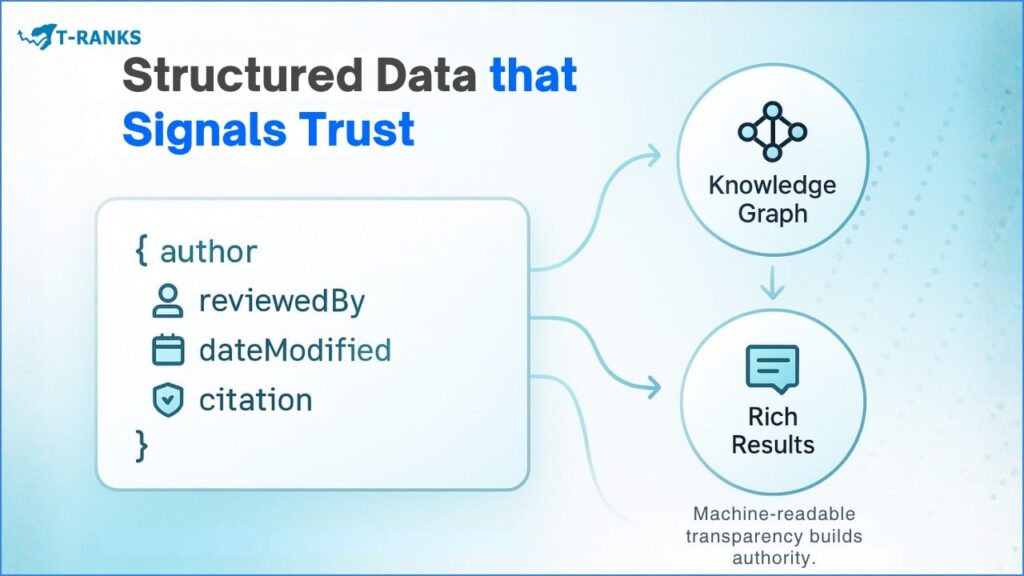
Structured data is how you translate your credibility into a language search engines can read.
It uses schema markup , small pieces of code that describe your content, authors, and organization in a structured format.
When you add schema correctly, Google, Chatgpt, and other AI systems can clearly understand who created your content, what qualifies them, and why it’s trustworthy.
In short, structured data helps you turn E-E-A-T signals into visible proof for algorithms.
It connects your people, brand, and expertise into a verified network that strengthens your authority online.
Why Structured Data Matters for E-E-A-T
Search engines don’t just read your words , they interpret data.
Structured data provides that context. It tells Google things like:
- Who the author is and what they specialize in.
- Whether the content has been reviewed by an expert.
- Which organization published it.
- When it was last updated and if it follows factual sources.
When this information is properly marked up, it feeds into Google’s Knowledge Graph, confirming that your website, authors, and topics are credible entities.
This directly supports the Expertise, Authoritativeness, and Trust pillars of E-E-A-T.
Building Off-Page Trust for E-E-A-T
Off-page trust is how Google and AI systems verify what others think about your brand.
It’s your digital reputation proven through backlinks, reviews, media coverage, and public discussions not just what you say on your own site.
Search engines and AI models now rely on this external validation to measure Experience, Expertise, Authoritativeness, and Trust (E-E-A-T).
If credible sources reference your brand, it tells Google and other search engines that your expertise is recognized by others, not self-declared.
Why Off-Page Signals Still Matter in 2026
Backlinks, reviews, and brand mentions are still the backbone of both traditional SEO and AI-driven visibility.
- In traditional search results, backlinks act as votes of confidence. Each high-quality link passes PageRank and topical authority.
- In AI Overviews, those same citations determine which brands are referenced or quoted as trusted sources.
- Brand mentions even without links help build your entity footprint, proving your existence and expertise across the web.
In short, off-page trust is the bridge between reputation and ranking.
It tells both algorithms and users, “This source is proven, cited, and respected.”
How to Build Off-Page Trust Step by Step
1. Earn Third-Party Reviews
Collect honest reviews on trusted platforms like Google Business, G2, Capterra, or Trustpilot.
Focus on recency (fresh feedback every 90 days) and diversity (multiple locations, services, and reviewers).
Consistent reviews build user trust and signal brand activity to Google’s algorithms.
2. Use PR and Thought Leadership
Publish guest posts, op-eds, or expert commentary on credible media sites.
Every bylined article or feature acts as an editorial backlink and an E-E-A-T citation — proof that your insights are valued by external editors.
3. Earn Mentions and Citations from Experts
Collaborate with universities, trade associations, and professional bodies.
When your work is cited or referenced by these institutions, it becomes a high-trust endorsement that few competitors can match.
4. Leverage HARO and Journalist Platforms
Join platforms like Connectively (HARO) to contribute verified expert quotes to journalists.
These quotes often generate backlinks from major publications and reinforce your topical authority.
5. Participate in Genuine Communities
Engage thoughtfully in Reddit threads, Quora answers, or niche industry forums.
Non-promotional, experience-based participation helps AI systems recognize your expertise through context and consistency.
How to Measure Off-Page Trust
Track off-page trust like you track backlinks — by quality, variety, and freshness.
Focus on three dimensions:
- Recency: How recently have you been mentioned or reviewed?
- Diversity: Are mentions coming from different domains, regions, and formats?
- Domain Quality: Are the referring sites authoritative and relevant to your niche?
Each verified mention or review becomes a digital vote that boosts your brand’s authority footprint across both SERPs and AI Overviews.
- One new review campaign per month.
- One expert quote or HARO placement per month.
- One editorial or PR feature per quarter.
Over time, this steady pattern builds a visible, trusted brand that AI systems consistently cite — turning off-page signals into your strongest E-E-A-T amplifier.
Safety, Transparency, and Provenance: The Final Layer of E-E-A-T
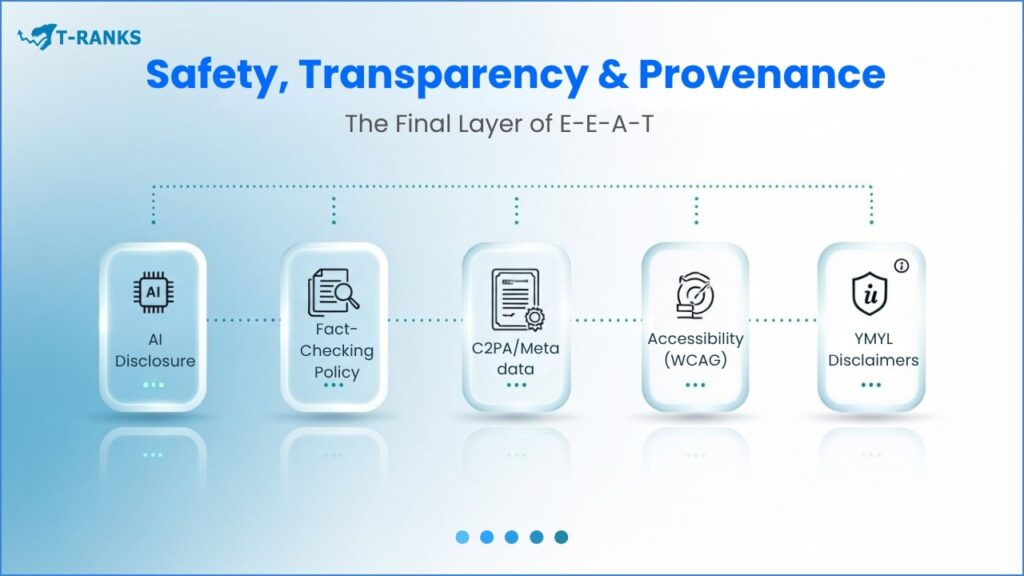
Safety and transparency are the final proof of trust in your E-E-A-T strategy.
They show that your content isn’t just expert-led it’s responsibly produced, ethically reviewed, and safe for users to consume.
In 2026, Google and AI systems like Gemini and Perplexity give more weight to brands that clearly disclose how their content is created, verified, and protected.
These signals help both algorithms and readers confirm that your website follows real-world publishing standards, not just SEO practices.
Why Safety and Provenance Matter
Search engines and users now demand traceable credibility.
AI systems cross-check who made the content, whether it was human-verified, and how sources are documented.
If your pages include visible safety and provenance markers such as AI disclosures or metadata , they are far more likely to be cited and trusted in AI Overviews.
In short, you can’t claim trust; you must show it.
1. AI Use Disclosure – Be Honest About Creation
If AI tools assist in your process, say so clearly.
Explain how AI was used for research, data processing, or drafting — and confirm that all final content was fact-checked and approved by qualified humans.
This balance shows transparency without undermining credibility.
Pro Tip: Add a short AI disclosure near your author bio or footer for consistency.
2. Fact-Checking and Editorial Policy – Show Oversight
Publish a concise statement describing how your content is verified.
List reviewer roles, fact-checking procedures, and update frequency.
Link this statement in your footer or About page so it’s visible site-wide.
Why it matters: It tells Google that your content is maintained, not abandoned.
3. Image Provenance – Prove Visual Authenticity
Every original photo or visual asset should include embedded metadata (IPTC or C2PA).
This confirms ownership and prevents AI or others from misusing your visuals.
It also helps Google’s image systems recognize that your media is authentic and traceable.
Example: Add creator name, date, and usage license in each image file’s metadata.
4. Accessibility Statement – Make Content Inclusive
Accessible design isn’t just good practice — it’s part of trust.
Ensure your site meets WCAG standards, includes descriptive alt text, and works with screen readers.
This signals that your brand values inclusivity and user care, strengthening perceived reliability.
5. YMYL Disclaimers – Protect Users and Show Accountability
For health, finance, or legal topics, always include a disclaimer clarifying that your content is educational, not professional advice.
Mention who reviewed it, their credentials, and when it was last verified.
This transparency protects both your readers and your brand.
Building Continuous Transparency
Together, these practices form the safety layer of E-E-A-T the final proof that your brand operates responsibly and prioritizes user well-being.
Make each disclosure visible across your site, not hidden in fine print.
Pro Tip: Turn these elements AI disclosure, fact-checking policy, provenance metadata, and disclaimers into reusable CMS components so they appear automatically on every page.
Consistent transparency reinforces trust with users, search engines, and AI models alike.
How E-E-A-T Differs for YMYL and Non-YMYL Content

Not all content needs the same level of proof.
Google applies higher E-E-A-T standards to some topics especially those that affect people’s health, money, safety, or well-being.
These are called YMYL pages, short for Your Money or Your Life.
If your content could influence a reader’s medical decision, legal action, or financial choice, it falls under this category.
That means Google expects stronger evidence, expert validation, and transparent disclaimers.
On the other hand, non-YMYL pages such as lifestyle, travel, hobbies, or marketing guides have more flexibility.
They still need to be trustworthy, but personal experience and practical insights carry more weight than formal credentials.
Why the Standards Are Different
For YMYL topics, the stakes are higher.
Misinformation in these areas can harm users, so Google’s systems use stricter trust checks.
That’s why YMYL content must be expert-reviewed, well-cited, and regularly updated.
Non-YMYL content, in contrast, builds trust through authenticity — showing real use, clear authorship, and responsible updates.
Both are important, but they’re measured differently.
For example:
A medical article on “how to manage blood pressure” needs a doctor’s review, clinical citations, and a visible disclaimer.
A lifestyle post on “morning routines for focus” can use firsthand experience, interviews, or credible non-academic sources — as long as it’s honest and helpful.
How Google’s Expectations Differ
| Criteria | YMYL Pages (High-Risk) | Non-YMYL Pages (Low-Risk) |
| Reviewer Type | Licensed or certified expert (MD, JD, CFA, PhD) | Internal editor, practitioner, or niche specialist |
| Update Cadence | Quarterly or after policy or regulation changes | Annually or when content becomes outdated |
| Source Strictness | 70–80% from .gov, .edu, or peer-reviewed journals | Mix of reputable blogs, reports, and firsthand data |
| Allowable Claims | Must be factual, evidence-based, and neutral | Can include personal insights or informed opinion |
| Schema Markup | Required — reviewedBy, citation, lastReviewed | Recommended — author, publisher, dateModified |
| Disclosures | Mandatory medical, legal, or financial disclaimers | Optional editorial transparency |
| AI Use | Must confirm human validation and expert oversight | AI assistance allowed with visible human review |
Internal Linking as Trust Flow
Internal linking isn’t just about helping users move around your website. It’s how Google and AI systems understand what your site values most and how your expertise is organized.
Think of it as your trust distribution network ,moving credibility, context, and authority from one page to another.
In 2026, search engines read internal links as editorial endorsements, not just navigation.
When your most trusted pages link to key content, Google treats it as a signal that says, “This page is important and reliable.”
How Trust Flow Works
Internal links act like digital pathways that carry trust throughout your website.
- Trust-dense pages — like About, Press Mentions, Reviews, or Methodology — hold proof of credibility. They already show credentials, citations, or recognition from external sources.
- Pillar pages — your main guides or service pages — gain strength when these trusted pages link to them. It’s like transferring reputation directly.
- Entity-rich anchors (for example, “See our E-E-A-T Framework reviewed by Dr. Liu”) help algorithms connect who is endorsing what and why it matters.
This structure creates a clear, measurable flow of both ranking power and trust signals, helping Google map how your expertise spreads across related topics.
Why Internal Linking Builds E-E-A-T
Every internal link you create is a silent vote of confidence.
A contextual link from your About or Press page doesn’t just pass PageRank — it shows editorial approval.
It tells search engines:
“We, the verified source, stand behind this content.”
Over time, these links form a hierarchy of credibility:
- Your verified pages (with bios, mentions, and credentials) act as trust sources.
- Your core pillars and clusters act as trust receivers.
As this network strengthens, your site develops deeper topical authority, making it easier for AI systems to cite and recommend your content.
How to Build a Trust Flow Strategy
- Start from Verified Pages
Link out from pages that already hold external trust — such as About, Review, or Press pages — to your key topics and product hubs. - Use Contextual,Descriptive Anchors
Avoid generic “read more.” Use entity-based phrases like “E-E-A-T implementation guide” or “Google-verified SEO methodology.” - Link Clusters Intelligently
Connect pillar pages to their related clusters and support articles. This shows Google how your knowledge expands within one topic area. - Maintain a Consistent Structure
Review internal links quarterly to ensure every important page receives signals from trusted sources and related topics.
How to Measure and Maintain E-E-A-T (Measurement & Governance)
E-E-A-T isn’t a one-time setup — it’s a system that must be measured, updated, and governed.
In 2026, brands that treat trust like a KPI are the ones that stay visible in both Google Search and AI Overviews.
Measurement helps you track how credible and complete your content really is.
Governance keeps those trust standards consistent across every page, update, and reviewer.
1. Measurement — Track What Builds Real Trust
You can’t improve what you don’t measure.
By tracking key E-E-A-T metrics, you can see exactly where your credibility is strong — and where it needs work.
Here are the signals that matter most:
- Trust Panel Completion Rate — Check how many of your priority pages include author bios, expert reviews, citations, and disclosures.
- Citation Count and Quality — Track how many verified, authoritative sources support your claims. Prioritize .gov, .edu, and peer-reviewed journals.
- Brand Mention Velocity — Monitor how often your brand appears on trusted websites, media outlets, or discussion platforms.
- Expert Review SLA — Measure how quickly experts validate high-stakes or YMYL content.
- AI Overview Citations (AIO) — Track how often your pages are cited in Google’s AI Overviews, Gemini, or Perplexity.
Together, these metrics help you see whether your trust signals are improving or fading.
They also reveal which pages deserve the most attention in your next E-E-A-T update cycle.
2. Governance — Keep E-E-A-T Consistent and Transparent
Governance is what turns good processes into long-term credibility.
It’s how you make sure that every update, review, and correction follows the same standards.
Here’s how to manage it:
- Editorial Oversight: Editors maintain review workflows and ensure that every article meets the right trust thresholds.
- SEO Ownership: SEOs manage schema, structured data, and author markup to keep your technical signals clean.
- Expert Validation: Subject-matter experts (SMEs) verify factual accuracy and sign off on high-impact topics.
- Version Control: Keep a revision log that records what changed, when, and who approved it.
- Correction Workflow: Document errors publicly and fix them fast — transparency builds user confidence.
This process keeps your E-E-A-T signals fresh, auditable, and easy to maintain.
How to Recover from Low E-E-A-T Drops (Practical Recovery Playbook)
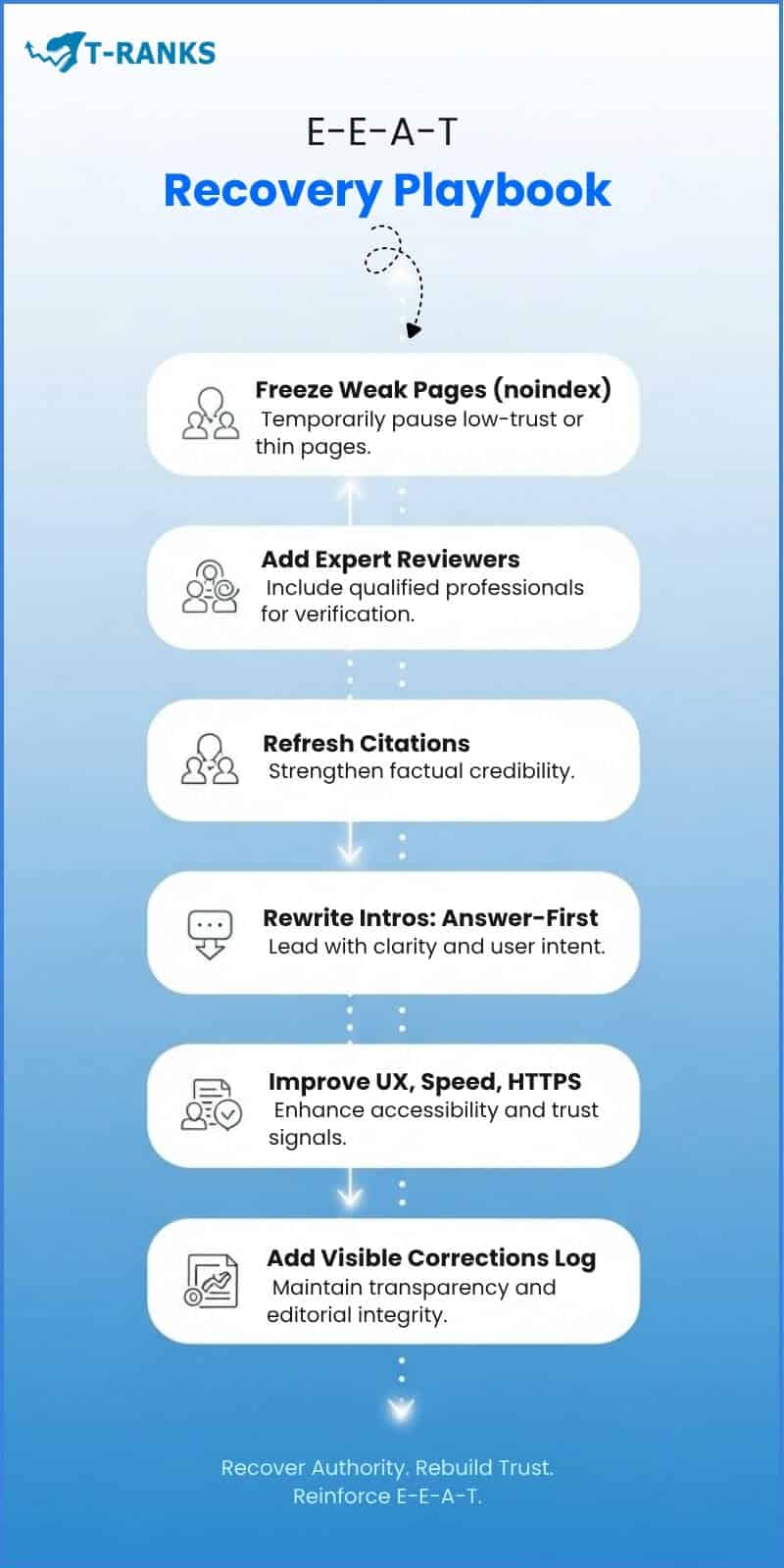
When your rankings or traffic suddenly fall after a Google update, it doesn’t mean your site is doomed.
In most cases, it means your trust signals weakened not that you were penalized.
The recovery path isn’t about deleting content or starting over.
It’s about rebuilding credibility one signal at a time.
Here’s a simple, proven playbook to help you recover.
1. Freeze Weak Pages Instead of Deleting Them
If some pages are thin or outdated, don’t rush to delete them.
Deleting removes backlinks and breaks your internal structure.
Instead, “freeze” weak pages with a noindex tag so Google knows you’re improving quality, not abandoning content.
Once refreshed, merge them into stronger, more complete pages.
This keeps your link equity intact while showing Google active maintenance.
2. Add Expert Reviewers to Rebuild Credibility
Google’s trust systems heavily rely on verified expertise especially for YMYL topics like health, finance, and safety.
Add a “Reviewed by” section showing the reviewer’s full name, title, and credentials.
For example: “Reviewed by Dr. Jane Doe, MD – Board-Certified Cardiologist.”
It tells users and algorithms that your claims have been fact-checked by professionals, not rewritten by AI.
3. Strengthen and Refresh Citations
Most low-E-E-A-T pages lack strong references.
Replace outdated or weak links with fresh, authoritative sources from .gov, .edu, or peer-reviewed publications.
Aim for at least 8–10 verifiable citations on in-depth guides.
Each credible link acts as evidence that your content is reliable, researched, and aligned with expert consensus.
4. Rewrite Intros in an Answer-First Format
Google’s AI Overviews and snippets favor content that answers questions clearly and fast.
Start every key page with a direct 2–3 sentence summary that delivers the main takeaway first.
Example:
“Heart disease symptoms include chest discomfort, fatigue, and irregular heartbeat.
Early diagnosis improves recovery — consult a doctor if these persist.”
This makes your content easy for AI systems to extract, cite, and summarize accurately.
5. Improve Site Experience and Visual Trust
Trust isn’t only about words — it’s also how your site feels.
Make sure your pages load fast, look clean, and work smoothly on mobile.
Add SSL (HTTPS), visible contact info, and minimal pop-ups.
A professional, secure layout shows users that your brand is legitimate and attentive to detail.
6. Create a Visible Corrections Log
Transparency is one of the fastest ways to regain credibility.
Add a small section at the bottom of each article labeled “Last Updated” or “Corrections.”
List any factual updates or reviewer confirmations there.
Example: “Updated Jan 2026 – Added citation from WHO and reviewed by Dr. Chen.”
It shows Google that your content is actively maintained and accountable.
Why This Works
Each of these steps sends a strong trust signal back to Google’s algorithms:
- Freezing pages stops quality loss.
- Expert review adds validation.
- Fresh citations prove accuracy.
- Answer-first intros improve visibility in AI Overviews.
- Transparent updates show ongoing care.
Within a few months, these signals compound — helping you regain rankings and visibility organically.
Pro Tip
Don’t treat recovery as a one-time fix.
Create a simple E-E-A-T maintenance checklist:
review top pages quarterly, refresh data, confirm expert reviews, and log all updates.
This routine keeps your site resilient through future algorithm shifts.
Conclusion
Building trust online is now just as important as using keywords or earning backlinks. To rank higher and stay visible, you need to show real knowledge, honest reviews, and clear transparency in everything you publish. When readers and Google can see that your information is accurate and verified, your website earns lasting credibility.
A strong E-E-A-T approach based on real experience, expert validation, and open communication turns trust into results. The brands that win today are those that prove what they know and keep their content genuine.Ready to grow your credibility?
Book your E-E-A-T audit and download the E-E-A-T Signals Worksheet to build a stronger, more trusted website today.
FAQs About E-E-A-T
How can I show real “experience” without sharing private client data?
You can prove experience without revealing details. Use blurred screenshots, anonymized invoices, or date-stamped photos. Host them on a “Methodology & Evidence” page and link from your articles to show genuine work while keeping client data private
Do reviews on third-party sites improve E-E-A-T or just help with sales?
They help with both. Reviews on Google, Trustpilot, or G2 act as trust signals for search engines and users. They build off-site credibility, support rankings, and increase clicks from AI results.
How often should experts review YMYL (Your Money or Your Life) pages?
For fast-changing topics like health or finance, review every quarter or after any rule change. For stable content, review once a year and show the reviewer’s name, credentials, and review date.
Can I use AI writing tools and still meet E-E-A-T standards?
Yes, as long as humans review and verify the content. AI can help draft or summarize, but experts should check accuracy and add firsthand insights. Always disclose AI use and list a human author.
Which schema markup builds the most trust?
Use Article or TechArticle schema with author, reviewedBy, and dateModified. Add Person schema for the author, Organization for your brand, and for YMYL content, include MedicalWebPage or FinancialService schema.
How can I track E-E-A-T improvements?
Set up a dashboard to track author profiles, citations, expert reviews, and brand mentions. Compare these signals with rankings and click-through rates to measure how your trust signals grow over time.
